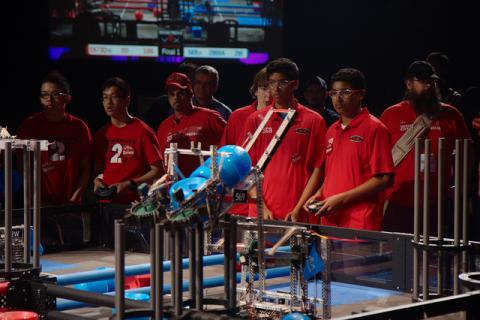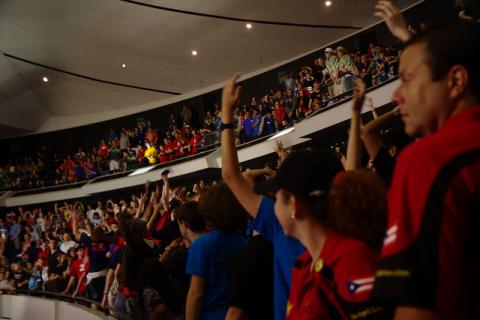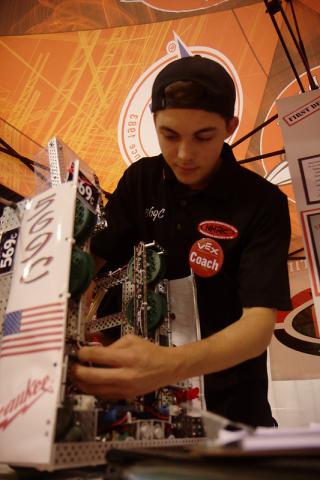Abstract:
This section provides an overview and simple tips to help a team prepare for a robotics competition.
Introduction:
The process of creating a robot - the final product - is only half the puzzle. A team’s performance at the competition will be the determining factor of their own success. Through effective strategy and scouting, teams can gain insights into their opponents’ style of play and diagram countermoves to gain an advantage. Teams can learn from their opponents and improve their own robot between matches. At this point it is almost like playing a high speed mechanized version of chess, or a miniature version of robot basketball.
Match Strategy:
 Robots come in varying degrees of ability. Some teams will have robots that move effortlessly across the field, picking up game objects at will and manipulating them in every which way, while other robots will look like a toddler trying to take his first steps. This level of ability is usually dictated by the decisions made throughout the engineering design process. Luckily for these weaker robots, early mistakes can be mitigated; robots can overcome superior robots by simply out strategizing them. Teams that go into the competition expecting to “wing it” each match will quickly realize they have put themselves at a large disadvantage.
Robots come in varying degrees of ability. Some teams will have robots that move effortlessly across the field, picking up game objects at will and manipulating them in every which way, while other robots will look like a toddler trying to take his first steps. This level of ability is usually dictated by the decisions made throughout the engineering design process. Luckily for these weaker robots, early mistakes can be mitigated; robots can overcome superior robots by simply out strategizing them. Teams that go into the competition expecting to “wing it” each match will quickly realize they have put themselves at a large disadvantage.
The first step towards competition success is developing a set of match strategies. A strategy should consist of a list of actions for the robot to perform during a given match. The strategy could be as simple as “Pick up game objects, score game objects”, or much more complicated, specifying exactly which footballs to pick up, what time they should all be picked up by, and what should be done with them. An extra degree of complexity would be to have different branches of a strategy, based on the conditions of the match (score, time remaining, opponent’s behavior, etc.) Teams should be careful, as there is such a thing as over planning a match.
Different strategies should be developed for different scenarios. To help develop these strategies teams should consider how they would play matches against potential opponents. For example:
- How would we play a match against a team who can score much faster than we can?
- How would we play a match if we were losing by a lot early on?
The more strategies a team has developed, the more prepared they will be for the dynamic situations they are sure to see during competition. As an exercise, have the students develop a strategy “playbook” in advance of the competition. This playbook will guide them through their matches at the competition. This playbook should always be a work in progress, as the more matches a team plays, the more new strategies they will develop. After all, these competition robotics matches are highly dynamic.
Scouting:
The best way to gain an advantage over an opposing robot is to know its strengths and weaknesses, as well as being able to predict its behavior. How can a team learn all this information? By a simple process known as “scouting.” Scouting consists of watching the matches of the other competing robots and recording the key information about their design and behavior. Things to look for include:
- Robot Functionality
- How well does the robot move?
- Does the robot have the capability to pick up the different types of objects?
- How does the robot score the different type of objects?
- Robot Behavior
- How many points did they score in each match? (An exact number)
- How many of each type did they score?
- What do they do at the start of the match? At the end of the match?
- What is their general strategy?
- When do they like to score?
- What is their general match flow?
By knowing what an opponent typically does in a match, a team can choose the appropriate strategy from their playbook based on what they expect to see in an upcoming match. This will allow a team to maximize the potential of their robot.
 During a competition teams should be scouting all of the matches, including their own. An exercise to be done before competition would be to have the teams each make up a “scouting sheet”. Each sheet would be a form to be filled out for each match, with fields to capture the data that team feels is most important. During the competition, students on the team would fill out a sheet for every team in every match. These sheets could then be used for quick reference when preparing for matches.
During a competition teams should be scouting all of the matches, including their own. An exercise to be done before competition would be to have the teams each make up a “scouting sheet”. Each sheet would be a form to be filled out for each match, with fields to capture the data that team feels is most important. During the competition, students on the team would fill out a sheet for every team in every match. These sheets could then be used for quick reference when preparing for matches.
To take things to the next level, teams can compile the data they have collected to calculate statistics to determine which robot is really the “best”. For example, “Team X is the best football scoring robot, scoring 4.3 footballs per match.”
Team Roles
During a competition there are four main roles that need to be filled by the students:
- Driver(s): These students are responsible for operating the robot during the actual matches. They will take strategic guidance from the coach during the match, as they try and lead their team to victory. Teams will have one or two drivers, depending on the design of their robot.
- Coach/Lead Strategist: This student will be responsible for making the final decision of what strategy to run during the matches. He/she will take input from the scouts to help make a decision. During the match, the coach will stand with the drivers, acting as their guide for the match. He/she will provide direction for the drivers and ensure that the appropriate strategy is being followed.
- Pit Crew: These students will be responsible for fixing, maintaining and improving the robot between matches. It is their responsibility to ensure that the robot is ready to compete for every match. They will also be in charge of maintaining all spare parts and batteries. Depending on the size of the team, the pit crew should be one or two people. If necessary, drivers can be members of the pit crew.
- Scouts: These students are responsible for watching every match and recording information about all the robots at the competition. They will work with the coach to prepare strategies for upcoming matches. This role should be filled by two students, with each watching one robot per match.
There are many ways to choose students for these roles. Some teams will be able to choose their roles on their own. Other teams will have difficulties arriving at a consensus. One scenario that is very common is multiple students wanting to be the driver. To help avoid this scenario, remind all teams that each role is integral to the team’s success, and no one role is more important than the other. Teams should also be taught to play to their strengths, putting people in roles that maximize the chance of success. One way to determine the driver is for the team to hold a mini competition between the candidates. Each driver will be given the robot on the playing field for two minutes, and whoever can score the most points is the winner.
Some teams will chose to alternate drivers to give multiple students an opportunity in the role. This approach can work, but having a single designated person for the role means a team will have a more practiced person driving, allowing for a greater chance of success at the competition.
Maximizing the Potential of a Robot at Competition
 There are many ways for teams to maximize the potential of their robot, many of which have been listed already. As the teams go through the competition they should be always be self-evaluating. Questions they should be asking include:
There are many ways for teams to maximize the potential of their robot, many of which have been listed already. As the teams go through the competition they should be always be self-evaluating. Questions they should be asking include:
- Could we be doing better?
- Do we need more strategies? Different strategies?
- Are we using our scouting data effectively?
- Is the robot working the way it is supposed to?
- Is it too slow? Is it being unreliable?
- Are teams picking up on our strategies? How do we adapt?
- Are our opponents better than us? Why? What are they doing that we are not?
Improving a Robot at Competition
Throughout the units in this curriculum, students learned that design is an iterative process. The iterative process does not have to end when competitions begin. The competition is just another test where teams can gather data and identify areas of improvement. A team may not be able to make large scale changes in the midst of a competition, but there is definitely room for tweaking. If the robot is not performing mechanically the way a team hopes it would, they should be working to find the cause and identifying avenues to rectify the situation. Good communication between all team members is essential for this process to work. When one person identifies a problem, it is essential that he/she communicates it to the pit crew so they can begin working on a solution.
General Competition Tips
- Reliability is the best robot feature of all. You can’t win if your robot doesn’t work.
- A day of testing is more important than a day spent cramming one last feature into your robot.
- Before every match, make sure that your battery is charged, fastened securely, plugged in, and most of all, that your robot is turned on.
- Never panic during the tournament!
- Expect everything on the robot to break at least once. Be prepared to fix it!
- If something goes wrong with your robot, don’t stress out too much; seek help and work on solving the problem.
- If you want to do well during the tournament, pick your drivers ahead of time and give your drivers a lot of practice before and during tournaments.
- Don’t ever lose hope. Even if your team is struggling there is still time to turn things around. Keep working to make your team the best it can be.
- Situations beyond your control will occur. Do not panic, just work on fixing and improving that which is within your control.
- Develop excellent communication between the pit crew and drive team.
- Read the VEXnet User Guide thoroughly and learn what every flashing light on the controller means. Make sure to check those lights before each match.
- Check all systems before every match. Use checklists; they ensure that nothing gets missed by accident.
- Make sure your PWM cables plugged are into the right ports and are seated tightly.
- Enter every match with a strategy. What will you do?
- Do not be afraid to look around and learn from other teams. Some of the best learning and inspiration will come from seeing the accomplishments of others.
- Get everyone involved. Even the newest team member can have the one great idea.
- Hard work and enthusiasm is always a winning combination.
- Have fun!
